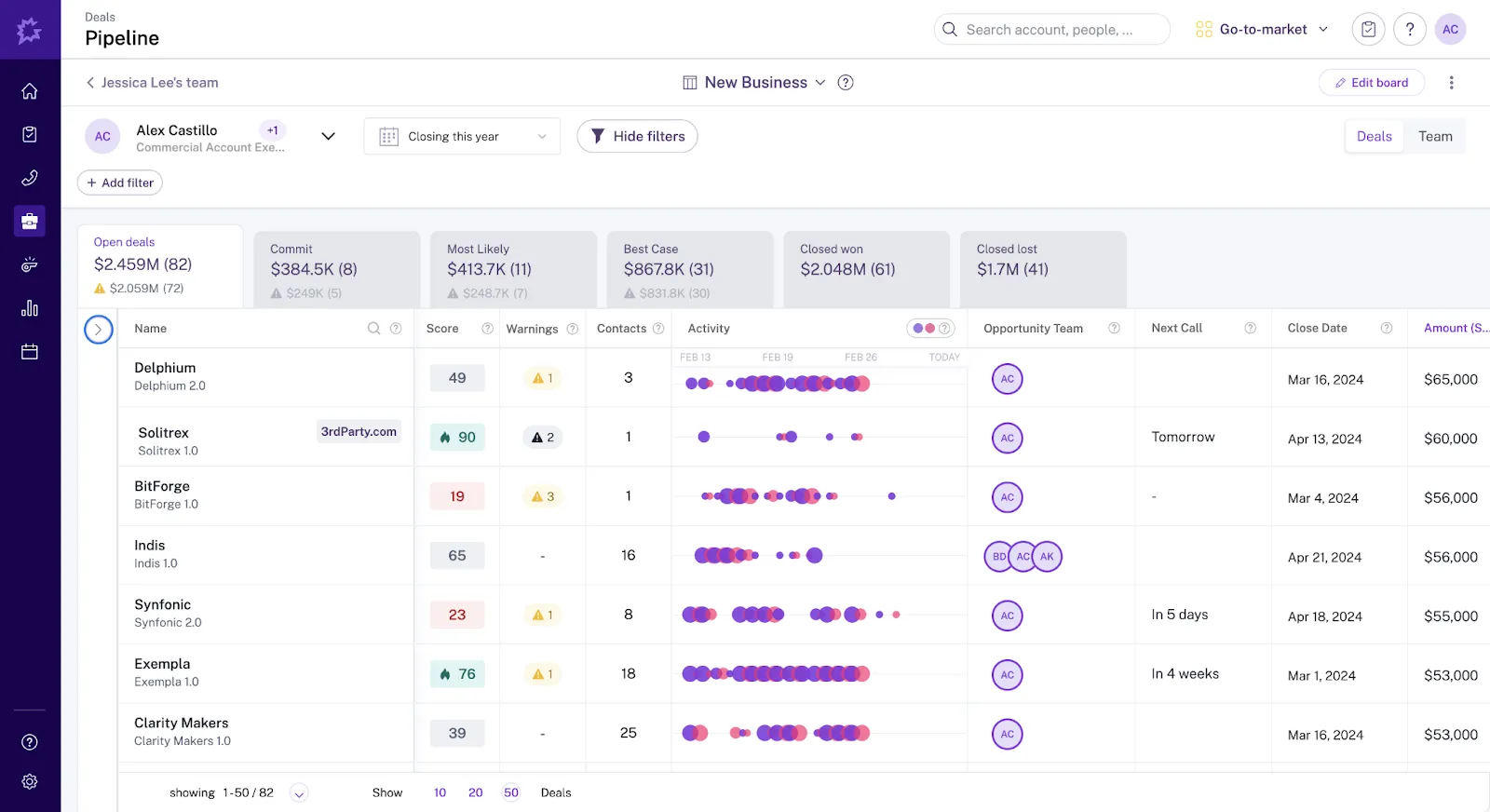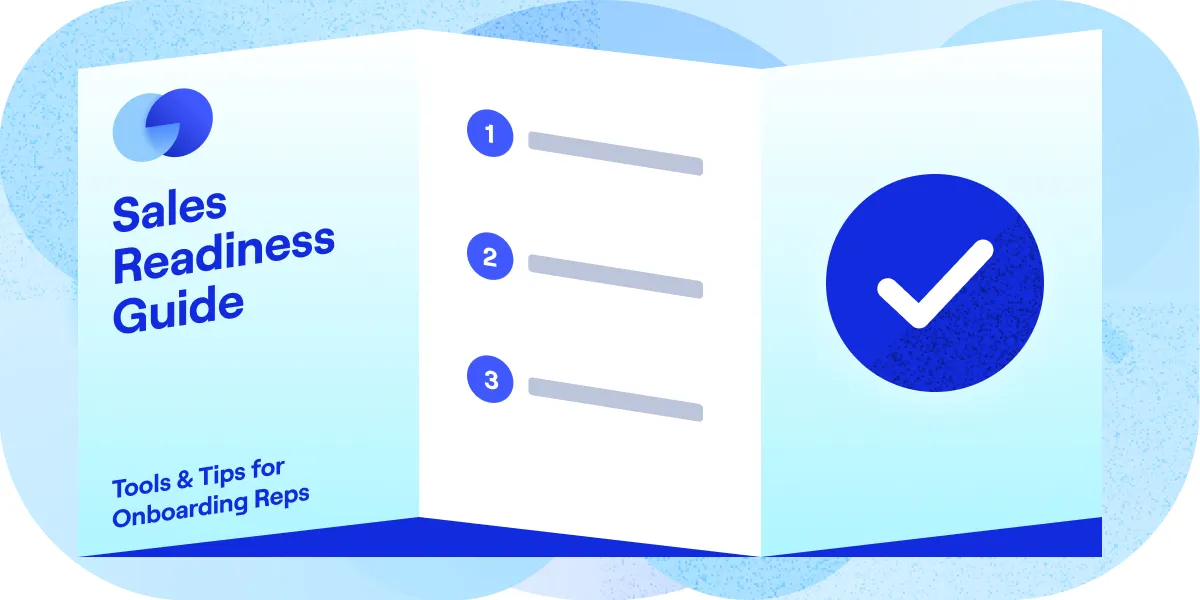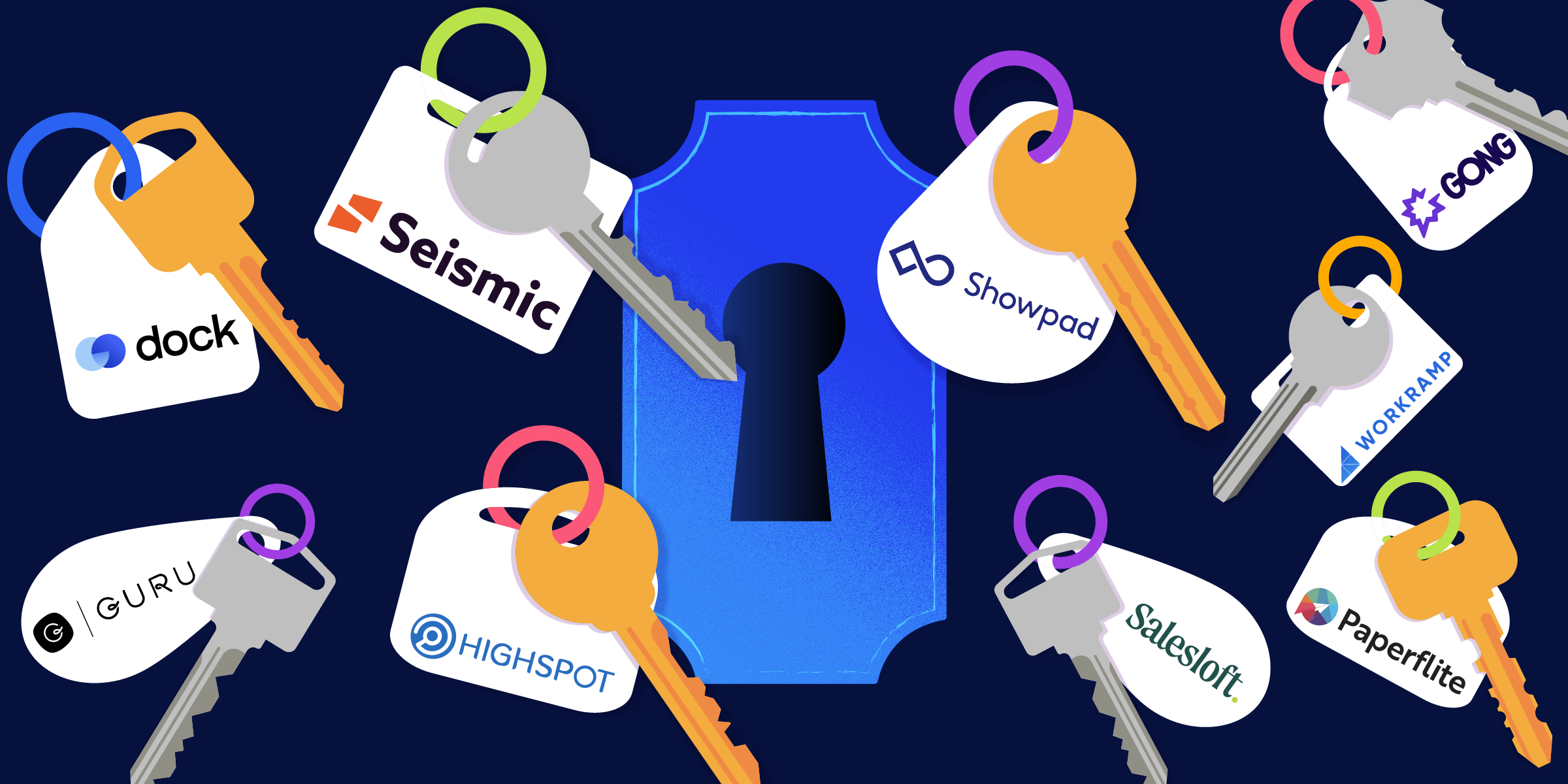Product
TABLE OF CONTENTs
TABLE OF CONTENT
Predicting the future is a skill any founder or sales leader wishes they had. Wouldn’t it be great to know exactly how much revenue you’d generate this month, this quarter, or this year?
Unfortunately, crystal ball technology isn’t quite where we need it to be yet. But we do have tips on the next best thing — sales forecasting tools.
A sales forecasting tech stack provides insights into every step of the customer journey so you can generate more accurate sales projections and make better decisions. Here’s everything you need to know.
How to think about sales forecasting software
Sales forecasting software is an umbrella term for tools that collect, monitor, and analyze sales-related data to help sales teams predict future sales figures.
Think of sales forecasting software as a system of tools rather than one app that covers all your bases.
In the beginning, small businesses and startups often turn to spreadsheets to track sales performance and progress, but at some point in your company’s growth lifecycle, Excel formulas won’t cut it anymore and you’ll need to adopt more advanced forecasting solutions.
In addition to measuring actual sales to historical sales and goals, sales forecasting software uses algorithms and AI to provide in-depth insights, project into the future, and improve decision-making.
A comprehensive sales forecasting tech stack covers your sales pipeline and customer journey at both a macro (your whole pipeline) and micro (individual deals and connections) level.
Your sales forecasting software should be able to:
- Organize and house all important customer information and sales data
- Provide a high-level view of challenges, risks, and opportunities within your sales pipeline
- Identify product-qualified leads ready to buy
- Offer strategic insights to improve customer relationships and pipeline efficiency
- Facilitate connection and collaboration with prospects and customers
Depending on your needs, one tool might do the trick, but most startups need to build a custom tech stack to generate accurate, useful sales forecasts.
How to build a sales forecasting tech stack
We’ve broken the typical sales forecasting tech stack down into five high-level categories:
- CRMs
- Revenue intelligence
- Conversation intelligence
- Product-led sales tools
- Buyer engagement tools
We’ll dive deeper into each tool type and how it contributes to accurate forecasting — but first, some stack-building reminders:
- Focus on solving needs, not checking boxes. You don’t need a tool from each of our categories. Some tools might overlap, or your team might not find value in certain features or products. Focus on what works for you.
- An all-in-one tool isn’t always the best tool. Less can be more when it comes to software, but don’t settle for a one-size-fits-some product if it doesn’t actually align with your goals.
- Tech stack integration should be easy. Think about how your tech stack will communicate. If data can’t flow freely from one tool to another, sales forecasting will be challenging.
- Common goals don’t necessarily mean common needs. Your sales team might all be focused on accomplishing the same goal, but they’ll likely have different software requirements and priorities. Make sure all management levels are considered.
- Buy for today, but plan for tomorrow. Tools should support you in your current growth phase while enabling you to reach that next level. Consider how your tech stack will impact your plans to scale.
1. CRM
Your sales forecasting foundation
Your CRM software is your sales home base. It collects, congregates, and houses all your customer and deal data, providing your sales team with real-time information about leads and prospects, deal progress, and quotas and goals.
CRMs make sales forecasting data easily digestible. It takes raw information from the other tools within your tech stack and displays it in relevant, contextualized, custom reports and dashboards.
Chances are, your team is already using a CRM. If you’re happy with your platform, there’s really no need to switch — but here are the features to look out for when selecting a CRM for sales forecasting:
- Two-way sync to automatically share data between tools and platforms
- Intuitive UI to make it easy for all team members to use, regardless of technical skill level
- Customizable dashboard views for personalized forecasting insights
- Built-in forecasting dashboards and views
A big-name sales CRM, like Salesforce CRM, will have more baked-in forecasting features and abilities, which is helpful for large enterprise teams with complex selling structures but can be clunky or difficult to use for some.
For a simpler interface, consider Hubspot CRM. It’s easier to use, but it also requires setting up your own custom forecasting reports.
2. Revenue intelligence tools
Your sales pipeline inspector
A revenue intelligence tool analyzes your sales pipeline to identify behaviors or actions that impact revenue. This might include:
- Identifying red-flag communication cadences that cause leads to slip through cracks in your funnel
- Finding pipeline gaps or lagging deal velocity
- Providing rep- or team-specific insights to gauge quota performance
- Tracking qualified leads for upsell or cross-sell opportunities
- Resurfacing stalled deals that have the potential to close
Revenue intelligence uses data, AI, and machine learning to predict trends and anticipate outcomes that will impact your bottom line. This results in more accurate sales and revenue forecasts. Insights are focused on closing more, bigger deals, and generating more revenue.
Tools tend to take one of two approaches to revenue intelligence: numbers-first or connections-first.
Clari, a purpose-built revenue platform, is a numbers-first tool designed to support everyone from CRO to account executive. It collects data from multiple revenue inputs, including your CRM, email, and conversation intelligence, to provide a holistic view of your pipeline numbers.

Clari makes it easy to check the health of your deals, compare revenue across timelines, and accurately forecast performance.
Gong takes a slightly different approach. Gong focuses on customer interactions, offering account executives and managers with personalized guidance to better understand customer needs and close more deals.

The platform analyzes sales conversations in real time and identifies patterns or keywords that might indicate a deal is ready to close or is at risk.
While Clari and Gong offer a lot of the same features, Clari is better suited for more complex sales forecasting, while Gong works best for smaller teams. Gong focuses primarily on sales interactions, so the dataset used in forecasting revenue often misses key data points.
3. Conversation intelligence
Your customer relationship amplifier
Conversation intelligence uses sales data to guide account executives in building stronger customer relationships.
A conversation intelligence tool analyzes customer interactions to identify trends, challenges, and opportunities and recommend actions to move customers through the sales pipeline.
Conversation intelligence tools help to:
- Make every customer interaction valuable
- Create and leverage deal-closing playbooks and data-backed sales techniques
- Build long-lasting customer relationships
- Resolve problems that put deals at risk
- Coach new and experienced team members to boost team performance
As a sales forecasting tool, conversation intelligence helps predict deal likelihood and identify and resolve deals at risk. Built-in coaching recommendations improve team performance, creating more consistent and reliable sales experiences for customers.
Conversation intelligence and revenue intelligence often go hand-in-hand, so many tools will work for both.

Gong is a leader in both conversation intelligence and revenue intelligence, but conversation intelligence is where it really shines. Gong uses AI to analyze interactions between buyers and sellers to help boost team productivity and provide deep insights into active and at-risk deals.
Chorus is another great conversation intelligence tool option. Chorus integrates directly with ZoomInfo (its parent company) to collect contact and company information to make more informed conversation recommendations.

You get a more holistic picture of deal health, but Chorus doesn’t use AI or offer revenue intelligence insights.
If the accuracy of your sales forecasts depends on touchpoints outside of sales, Chorus is a strong choice. However, Gong’s AI features, revenue intelligence capabilities, and easy-to-use platform make it a more robust tool.
4. Product-led sales tools
Your automated lead qualifier
Product-led sales tools help identify product-qualified leads (PQLs). These leads are in your target audience, are already using your product, and show intent to purchase.
PQLs are identified using a combination of product and CRM data. Rather than getting the “qualified” stamp of approval from a sales rep, a lead becomes “product-qualified” after completing certain actions in your product (e.g., inviting another member of their company to your tool).
A product-led sales tool tracks lead behavior to flag profiles that might be ready to buy. More accurate lead qualification leads to more accurate sales forecasting.
Pocus is a top pick for product-led sales. It uses AI to analyze product usage data and intent signals to help prospect and optimize outreach. In addition to streamlining opportunity discovery, Pocus uses playbooks to automate outreach and recreate positive customer experiences.

Headsup and Endgame are other great options for product-led sales.
Product analytics platforms are another option to consider for product-led sales teams and forecasting.

An analytics tool, like Mixpanel, provides insights beyond just the sales team. It shows how users are engaging with your product throughout their entire customer lifecycle. Where tools like Pocus tend to become less valuable when a lead becomes a customer, Mixpanel or another product analytics tool continues to drive long-term customer relationships.
5. Buyer engagement tools
Your buying process tracker
Most sales forecasting tools focus on buyer-seller interactions from the seller’s perspective, tracking touchpoints like sales calls and product engagement. But this approach alone fails to account for the engagement happening (or not happening) on the buyer’s side.
Buyer engagement tools track potential buyers’ actions outside of the traditional sales opportunity stages, like revisiting a slide deck or forwarding a demo to their boss.
A versatile and flexible tool (like Dock) can cover tracking multiple buyer engagement metrics and processes.
Digital sales rooms
A digital sales room or sales deal room is a hub for collaborating with buyers and tracking engagement throughout the sales process.
It houses sales activities, content, action plans, quotes, forms, and more, all in a visually appealing, easy-to-engage-with dashboard. So your reps can quickly generate and personalize deal pages to match customers’ needs and keep them engaged with the sales process.
What does this have to do with forecasting?
Sales rooms improve forecasting accuracy by letting you track deal progress between the traditional deal stages in your CRM.
Sales room analytics allow for:
- Making your sales cycle more predictable: enabling sales leaders and account executives to recreate positive deal experiences using templates and historical data.
- Tracking deal progress between CRM stages: capturing all the micro-interactions to ensure nothing slips through the cracks.
- Track progress via mutual action plans: keeping everyone informed and on the same page about how the deal is progressing.
- Track multithreading: building personalized sales nurturing and product education plans for each purchasing stakeholder.
- Tracking content engagement: providing insight into how, when, and how often buyers are interacting with shared content to enable more personalized, focused interactions.

Mutual action plans
Mutual action plans tell both buyers and sellers what they need to do to close a deal. They’re particularly helpful for complex buying processes and managing multiple stakeholders.
Mutual action plans help break big processes into multi-phase stages, making it easier to get specific about how close a deal is to closing. It ensures all the little details that could delay or even kill a deal are handled.
Connect your mutual action plan with your CRM to keep progress up-to-date without extra work. The more accurate your CRM data is, the more accurate the forecasts you generate will be.

When creating mutual action plans in Dock, you can set automated reminders for when tasks are due. Everyone stays focused, so deals move through the funnel more efficiently.
And as a bonus, when customers convert from leads to buyers, your mutual action plan seamlessly turns into an onboarding checklist.
Content management
A content management tool stores and categorizes sales and marketing resources, making it easier to find and share. It also tracks content analytics, showing what resources are viewed, when, and for how long.
For forecasting purposes, a content management tool like Dock shows whether or not leads are actually engaging with the content they’re receiving.
Spending a significant amount of time viewing documents or watching videos can indicate a more qualified lead, while leads that frequently ignore new assets might not be worth the effort to revive.

Content management data provides insights into which assets impact deals, allowing the sales team to prioritize sharing the right resources and creating more high-value content.
Dock’s integration with Google Drive also makes it easy to keep content up to date. You can start getting content insights without needing to migrate sales content from where it currently lives.
Create a better sales forecasting process with Dock
Sales forecasting is an intricate process, but a critical one for new and growing startups. While the best sales insights come from a complete tech stack, a great place to get started is with a buyer engagement tool like Dock.
Improve sales forecasting by using Dock to:
- Streamline sales workflows and automate connections, next steps, and follow-ups
- Visualize deal progress and to-be-completed steps
- Collect sales analytics and make data-driven decisions
- Improve customer relationships and drive renewals
Ready to see for yourself? Sign up for Dock for free.




























.webp)







